high beam TOYOTA CAMRY HYBRID 2021 Owners Manual (in English)
[x] Cancel search | Manufacturer: TOYOTA, Model Year: 2021, Model line: CAMRY HYBRID, Model: TOYOTA CAMRY HYBRID 2021Pages: 624, PDF Size: 15.98 MB
Page 3 of 624

3
1
9 7 6
5
4
3
2
8
4-1. Before drivingDriving the vehicle ............. 198
Cargo and luggage............ 206
Vehicle load limits ............. 209
Trailer towing..................... 210
Dinghy towing.................... 211
4-2. Driving procedures Power (ignition) switch ...... 212
EV drive mode................... 219
Hybrid transmission........... 222
Turn signal lever................ 228
Parking brake .................... 229
Brake Hold ........................ 233
4-3. Operating the lights and wipers
Headlight switch ................ 236
AHB (Automatic High Beam) ............................. 240
Windshield wipers and washer ............................ 244
4-4. Refueling Opening the fuel tank cap .................................. 248 4-5. Using the driving
support systems
Toyota Safety Sense 2.5+ ...................... 252
PCS (Pre-Collision System) ........................... 260
LTA (Lane Tracing Assist).............................. 275
RSA (Road Sign Assist).............................. 290
Dynamic radar cruise control with full-speed
range ............................... 295
Driving assist systems ....... 311
BSM (Blind Spot Monitor) ........................... 318
• BSM function ................. 323
Intuitive parking assist ....... 327
RCTA (Rear Cross Traffic Alert) ..................... 335
• RCTA function ............... 337
Rear Camera Detection Function........................... 341
PKSB (Parking Support Brake) .............................. 345
Parking Support Brake function (static objects).... 352
Parking Support Brake function (rear-crossing
vehicles) .......................... 361
Driving mode select switches........................... 368
4-6. Driving tips Hybrid vehicle driving tips ................................... 370
Winter driving tips .............. 373
4Driving
Page 18 of 624
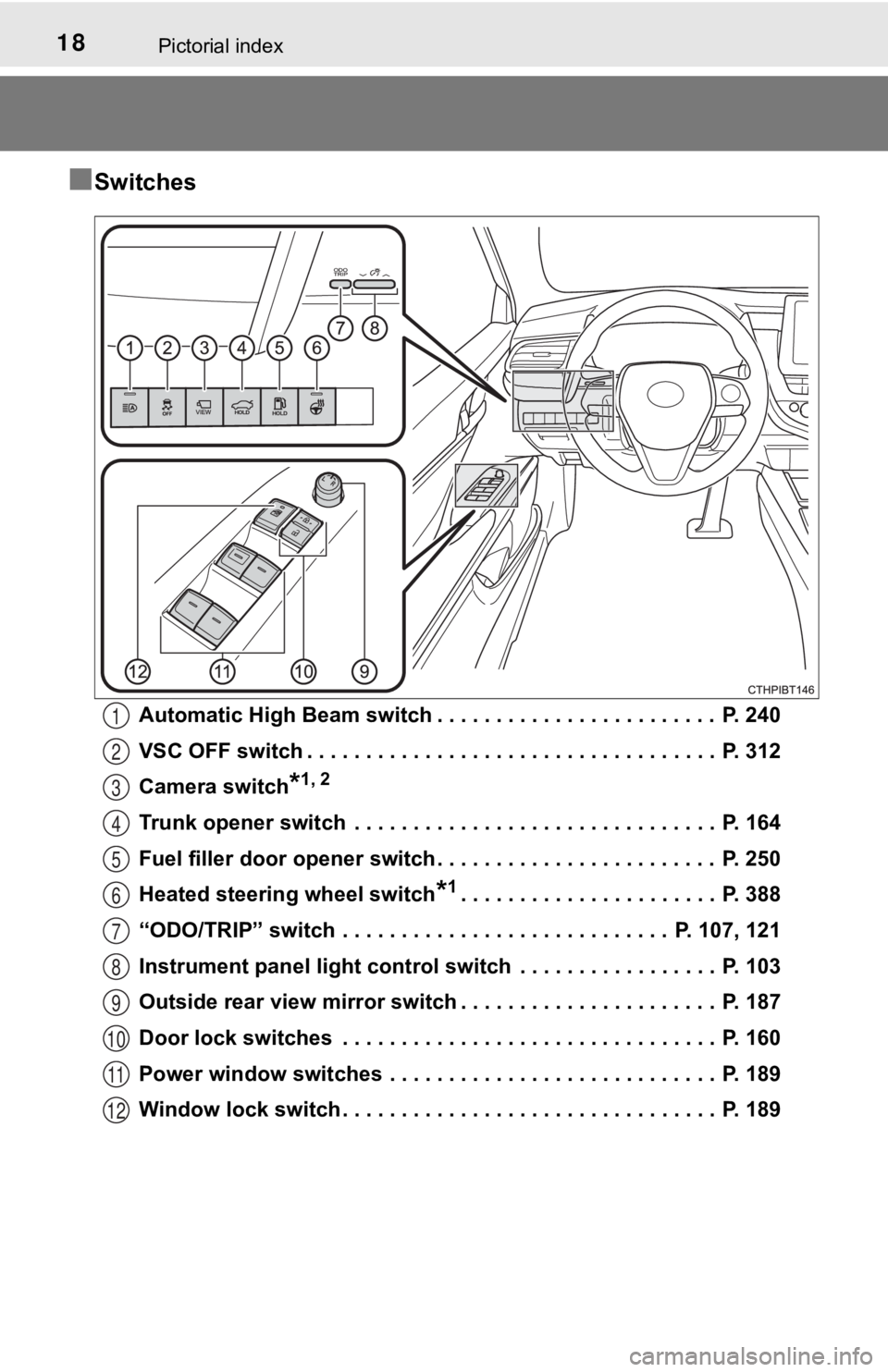
18Pictorial index
■Switches
Automatic High Beam switch . . . . . . . . . . . . . . . . . . . . . . . . P. 240
VSC OFF switch . . . . . . . . . . . . . . . . . . . . . . . . . . . . . . . . . . . P. 312
Camera switch
*1, 2
Trunk opener switch . . . . . . . . . . . . . . . . . . . . . . . . . . . . . . . P. 164
Fuel filler door opener switch . . . . . . . . . . . . . . . . . . . . . . . . P. 250
Heated steering wheel switch
*1. . . . . . . . . . . . . . . . . . . . . . P. 388
“ODO/TRIP” switch . . . . . . . . . . . . . . . . . . . . . . . . . . . . P. 107, 121
Instrument panel light control s witch . . . . . . . . . . . . . . . . . P. 103
Outside rear view mirror switch . . . . . . . . . . . . . . . . . . . . . . P. 187
Door lock switches . . . . . . . . . . . . . . . . . . . . . . . . . . . . . . . . P. 160
Power window switches . . . . . . . . . . . . . . . . . . . . . . . . . . . . P. 189
Window lock switch . . . . . . . . . . . . . . . . . . . . . . . . . . . . . . . . P. 189
1
2
3
4
5
6
7
8
9
10
11
12
Page 99 of 624
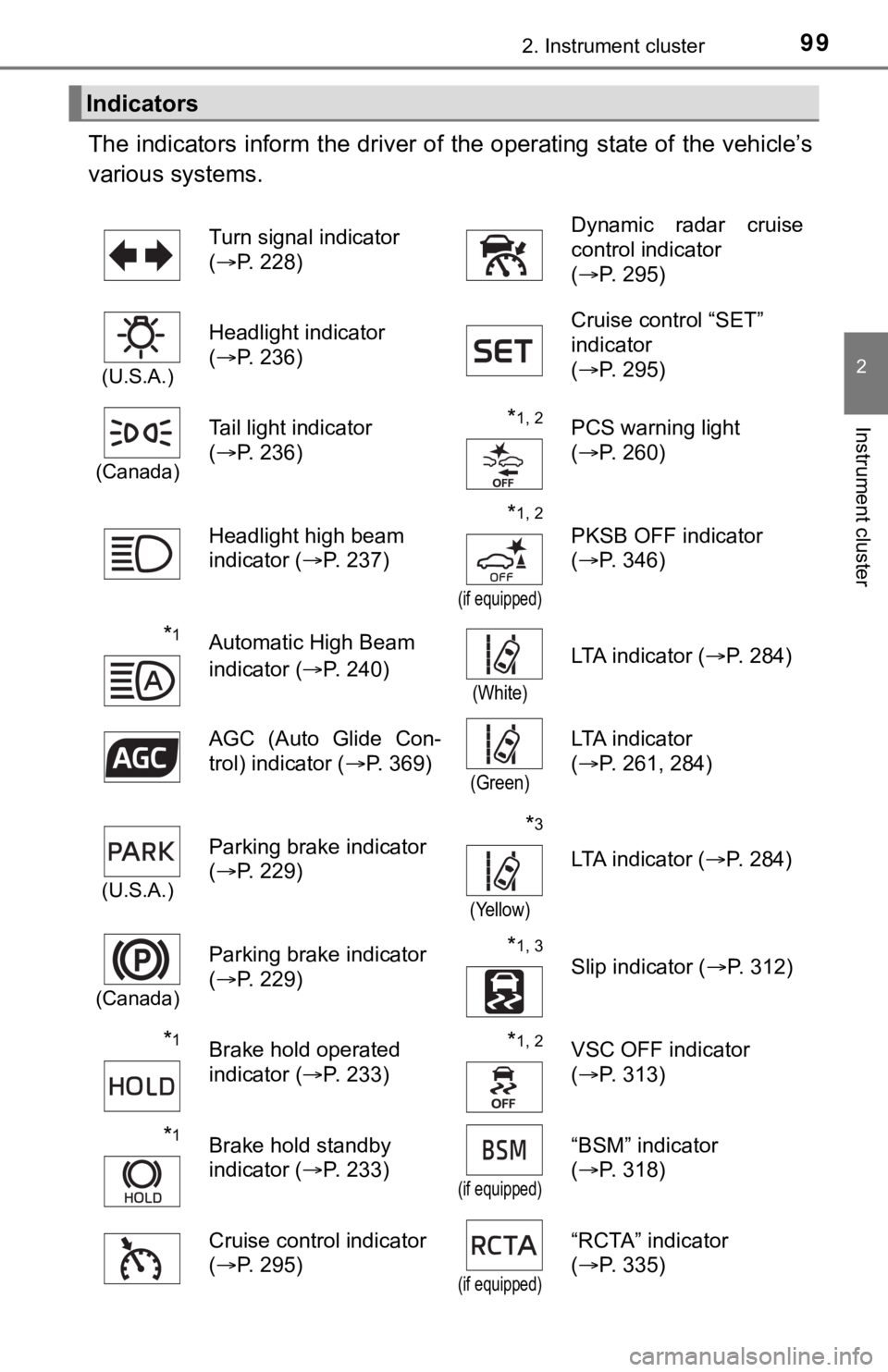
992. Instrument cluster
2
Instrument cluster
The indicators inform the driver of the operating state of the vehicle’s
various systems.
Indicators
Turn signal indicator
( P. 228) Dynamic radar cruise
control indicator
(
P. 295)
(U.S.A.)
Headlight indicator
(P. 236) Cruise control “SET”
indicator
(
P. 295)
(Canada)
Tail light indicator
(P. 236) *1, 2PCS warning light
(P. 260)
Headlight high beam
indicator ( P. 237)
*1, 2
(if equipped)
PKSB OFF indicator
(P. 346)
*1Automatic High Beam
indicator ( P. 240)
(White)
LTA indicator ( P. 284)
AGC (Auto Glide Con-
trol) indicator ( P. 369)
(Green)
LTA indicator
(P. 261, 284)
(U.S.A.)
Parking brake indicator
(P. 229)*3
(Yellow)
LTA indicator ( P. 284)
(Canada)
Parking brake indicator
(P. 229)*1, 3
Slip indicator ( P. 312)
*1Brake hold operated
indicator (P. 233)*1, 2VSC OFF indicator
(P. 313)
*1Brake hold standby
indicator ( P. 233)
(if equipped)
“BSM” indicator
(P. 318)
Cruise control indicator
( P. 295)
(if equipped)
“RCTA” indicator
(P. 335)
Page 197 of 624

197
4Driving
4-1. Before drivingDriving the vehicle ............. 198
Cargo and luggage ........... 206
Vehicle load limits ............. 209
Trailer towing..................... 210
Dinghy towing ................... 211
4-2. Driving procedures Power (ignition) switch ...... 212
EV drive mode .................. 219
Hybrid transmission........... 222
Turn signal lever................ 228
Parking brake .................... 229
Brake Hold ........................ 233
4-3. Operating the lights and wipers
Headlight switch ................ 236
AHB (Automatic High Beam) ............................. 240
Windshield wipers and washer ............................ 244
4-4. Refueling Opening the fuel tank cap .................................. 248
4-5. Using the driving support systems
Toyota Safety Sense 2.5+...................... 252
PCS (Pre-Collision System) ........................... 260 LTA (Lane Tracing
Assist) ............................. 275
RSA (Road Sign Assist) ............................. 290
Dynamic radar cruise control with full-speed
range............................... 295
Driving assist systems ...... 311
BSM (Blind Spot Monitor)........................... 318
• BSM function ................ 323
Intuitive parking assist....... 327
RCTA (Rear Cross Traffic Alert) .................... 335
• RCTA function .............. 337
Rear Camera Detection Function .......................... 341
PKSB (Parking Support Brake) ............................. 345
Parking Support Brake function (static objects) ... 352
Parking Support Brake function (rear-crossing
vehicles).......................... 361
Driving mode select switches .......................... 368
4-6. Driving tips Hybrid vehicle driving tips .................................. 370
Winter driving tips ............. 373
Page 237 of 624
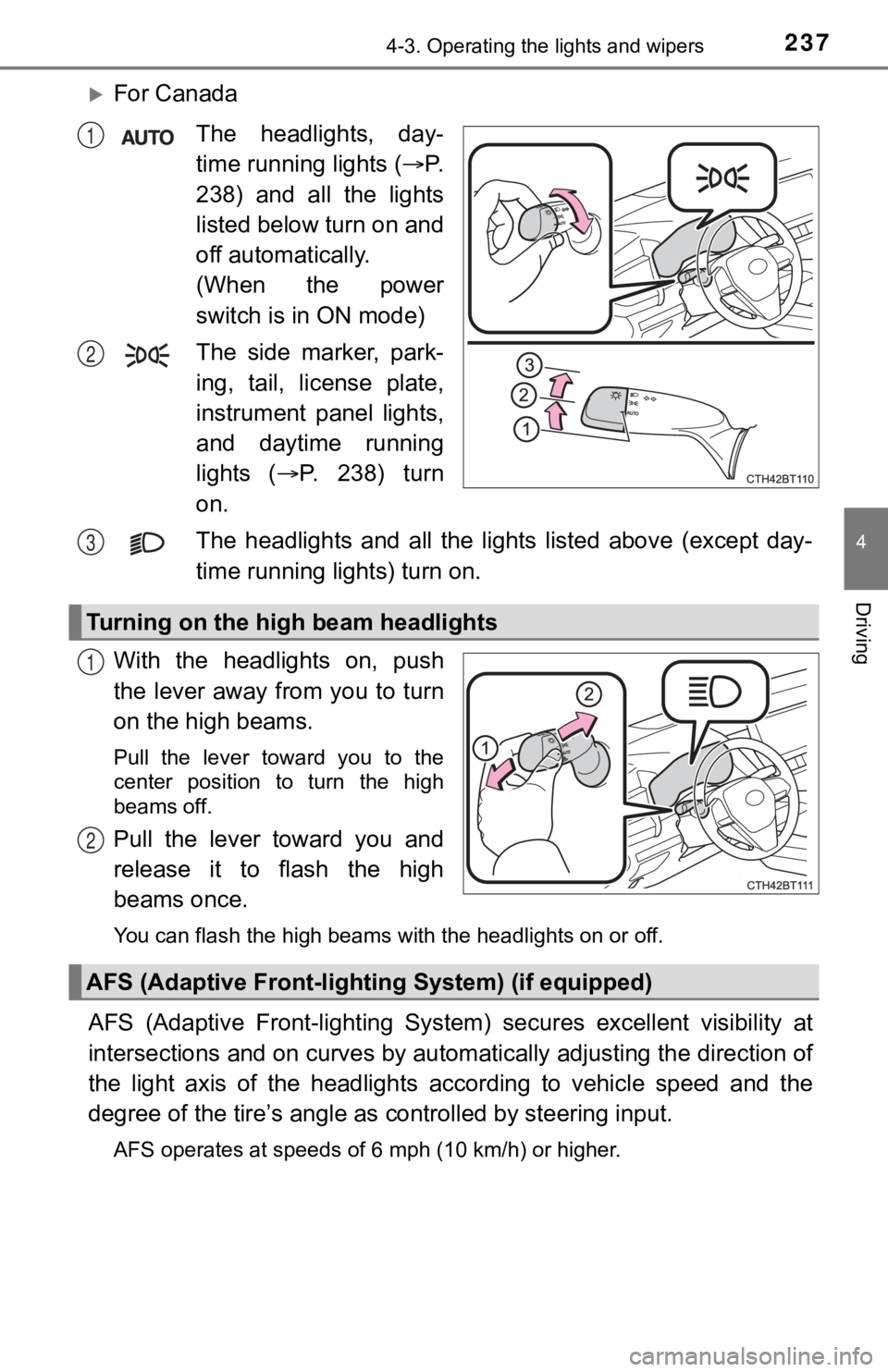
2374-3. Operating the lights and wipers
4
Driving
For Canada
The headlights, day-
time running lights
( P.
238) and all the lights
listed below turn on and
off automatically.
(When the power
switch is in ON mode)
The side marker, park-
ing, tail, license plate,
instrument panel lights,
and daytime running
lights
( P. 238) turn
on.
The headlights and all the li ghts listed above (except day-
time running lights) turn on.
With the headlights on, push
the lever away from you to turn
on the high beams.
Pull the lever toward you to the
center position to turn the high
beams off.
Pull the lever toward you and
release it to flash the high
beams once.
You can flash the high beams with the headlights on or off.
AFS (Adaptive Front-lighting System) secures excellent visibili ty at
intersections and on curves by automatically adjusting the dire ction of
the light axis of the headlights according to vehicle speed and the
degree of the tire’s angle as controlled by steering input.
AFS operates at speeds of 6 mph (10 km/h) or higher.
1
2
Turning on the high beam headlights
3
1
2
AFS (Adaptive Front-light ing System) (if equipped)
Page 240 of 624
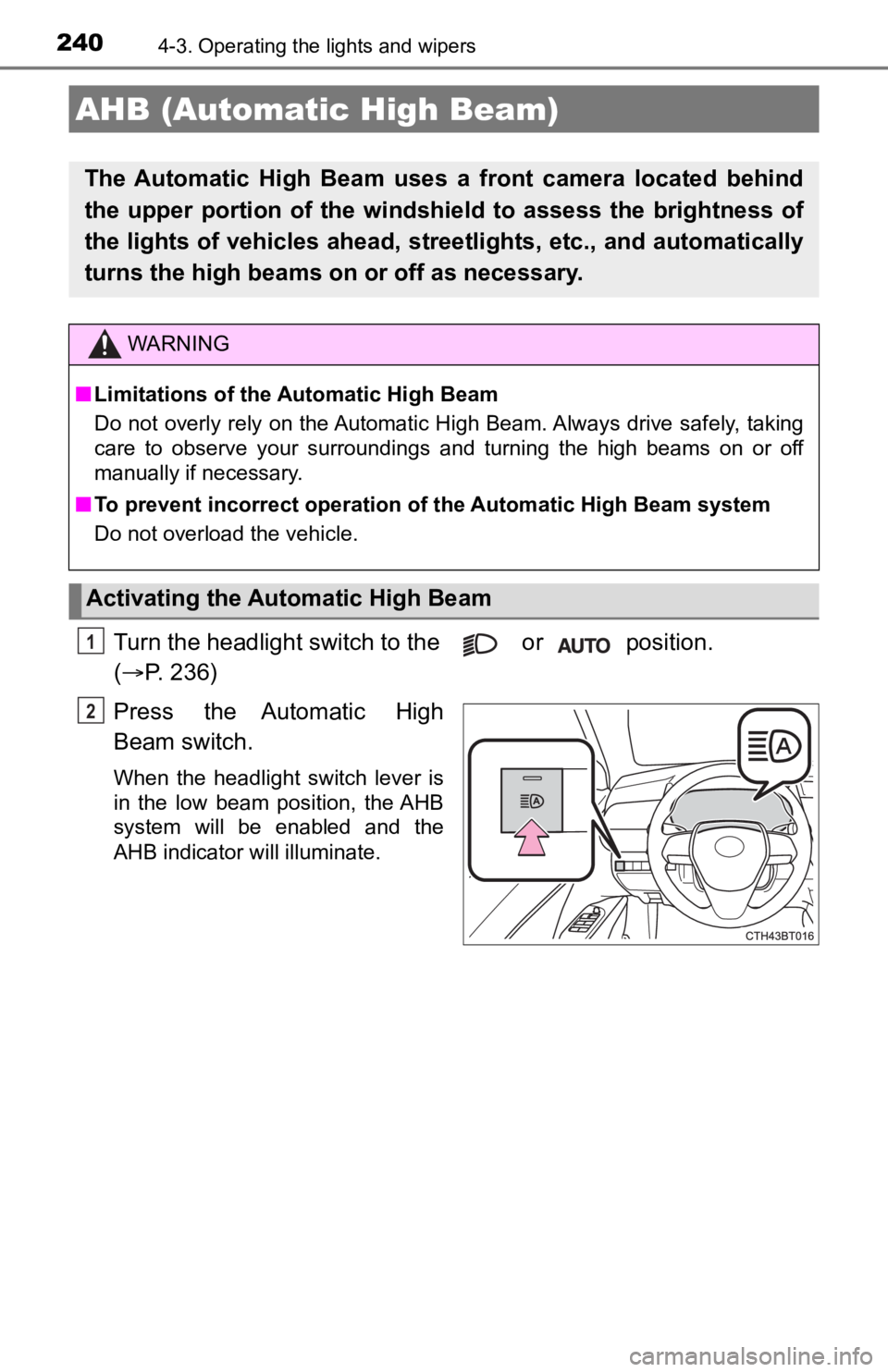
2404-3. Operating the lights and wipers
Turn the headlight switch to the or position.
( P. 236)
Press the Automatic High
Beam switch.
When the headlight switch lever is
in the low beam position, the AHB
system will be enabled and the
AHB indicator will illuminate.
AHB (Automatic High Beam)
The Automatic High Beam uses a front camera located behind
the upper portion of the windshi eld to assess the brightness of
the lights of vehicles ahead, streetlights, etc., and automatically
turns the high beams on or off as necessary.
WARNING
■Limitations of the Automatic High Beam
Do not overly rely on the Automatic High Beam. Always drive safely, taking
care to observe your surroundings and turning the high beams on or off
manually if necessary.
■ To prevent incorrect operation of the Automatic High Beam syste m
Do not overload the vehicle.
Activating the Automatic High Beam
1
2
Page 241 of 624

2414-3. Operating the lights and wipers
4
Driving
■Switching to the high beams
Push the lever away from you.
The Automatic High Beam indi-
cator will turn off and the high
beam indicator will turn on.
Pull the lever to its original posi-
tion to activate the Automatic
High Beam system again.
■
Switching to the low beams
Press the Automatic High
Beam switch.
The Automatic High Beam indi-
cator will turn off.
Press the switch to activate the
Automatic High Beam system
again.
■
Temporarily switching to the low beams
Pull the lever toward you and
then return it to its original posi-
tion.
The high beams are on while
the lever is pulled toward you.
However, after the lever is
returned to its original position,
the low beams remain on for a
certain amount of time. After-
wards, the Automatic High
Beam will be activated again.
■ Temporarily switchi ng to the low beams
It is recommended to switch to the low beams when the high beam may
cause problems or distress to other drivers or pedestrians near by.
Turning the high beams on/off manually
Page 242 of 624

2424-3. Operating the lights and wipers
■Conditions to turn the high beams on/off automatically
●When all of the following conditions are met, the high beams will be turned
on automatically (after approximately 1 second):
• The vehicle speed is approximately 21 mph (34 km/h) or more.
• The area ahead of the vehicle is dark.
• There are no vehicles ahead with headlights or tail lights turned on.
• There are few streetlights on the road ahead.
● If any of the following conditions is met, the high beams will turn off automat-
ically:
• The vehicle speed is below approximately 17 mph (27 km/h).
• The area ahead of the vehicle is not dark.
• Vehicles ahead have their headlights or tail lights turned on.
• There are many streetlights on the road ahead.
■ Front camera detection information
●The high beams may not be automatically turned off in the following situa-
tions:
• When a vehicle suddenly appears from around a curve
• When the vehicle is cut in front of by another vehicle
• When vehicles ahead cannot be detected due to repeated curves, road
dividers or roadside trees
• When vehicles ahead appear in a faraway lane on a wide road
• When the lights of vehicles ahead are not on
● The high beams may be turned off if a vehicle ahead that is usi ng fog lights
without its headlights turned on is detected.
● House lights, street lights, traffic signals, and illuminated billboards or signs
and other reflective objects may cause the high beams to change to the low
beams, or the low beams to remain on.
● The following factors may affect the amount of time taken for t he high
beams to turn on or off:
• The brightness of the headlights, fog lights, and tail lights of vehicles
ahead
• The movement and direction of vehicles ahead
• When a vehicle ahead only has operational lights on one side
• When a vehicle ahead is a two-wheeled vehicle
• The condition of the road (gradient, curve, condition of the r oad surface,
etc.)
• The number of passengers and amount of luggage in the vehicle
● The high beams may turn on or off unexpectedly.
● Bicycles or similar vehicles may not be detected.
Page 243 of 624

2434-3. Operating the lights and wipers
4
Driving
●In the following situations the system may not be able to correctly detect the
surrounding brightness level. This may cause the low beams to r emain on
or the high beams to flash or dazzle pedestrians or vehicles ah ead. In such
a case, it is necessary to manually switch between the high and low beams.
• When driving in inclement weather (heavy rain, snow, fog, sand storms,
etc.)
• When the windshield is obscured by fog, mist, ice, dirt, etc.
• When the windshield is cracked or damaged
• When the front camera is deformed or dirty
• When the temperature of the front camera is extremely high
• When the surrounding brightness level is equal to that of head lights, tail
lights or fog lights
• When headlights or tail lights of vehicles ahead are turned off, dirty, changing color, or not aimed properly
• When the vehicle is hit by water, snow, dust, etc. from a prec eding vehi-
cle
• When driving through an area of intermittently changing brightness and
darkness
• When frequently and repeatedly driving ascending/descending roads, or roads with rough, bumpy or uneven surfaces (such as stone-paved
roads, gravel roads, etc.)
• When frequently and repeatedly taking curves or driving on a w inding
road
• When there is a highly reflective object ahead of the vehicle, such as a sign or mirror
• When the back of a preceding vehicle is highly reflective, such as a con-
tainer on a truck
• When the vehicle's headlights are damaged or dirty, or are not aimed
properly
• When the vehicle is listing or titling due to a flat tire, a trailer being towed, etc.
• When the headlights are changed between the high beams and low
beams repeatedly in an abnormal manner
• When the driver believes that the high beams may be flashing or dazzling pedestrians or other drivers
■ Temporarily lowering sensor sensitivity
The sensitivity of the sensor can be temporarily lowered.
Turn the power switch off while the following conditions are me t.
• The headlight switch is in the or position.
• The headlight switch lever is in the original position.
Turn the power switch to ON mode.
Within 60 seconds after , repeat pushing the headlight switch lever to the
high beam position then pulling it to the original position qui ckly 10 times,
then leave the lever in the original position.
1
2
32
Page 252 of 624
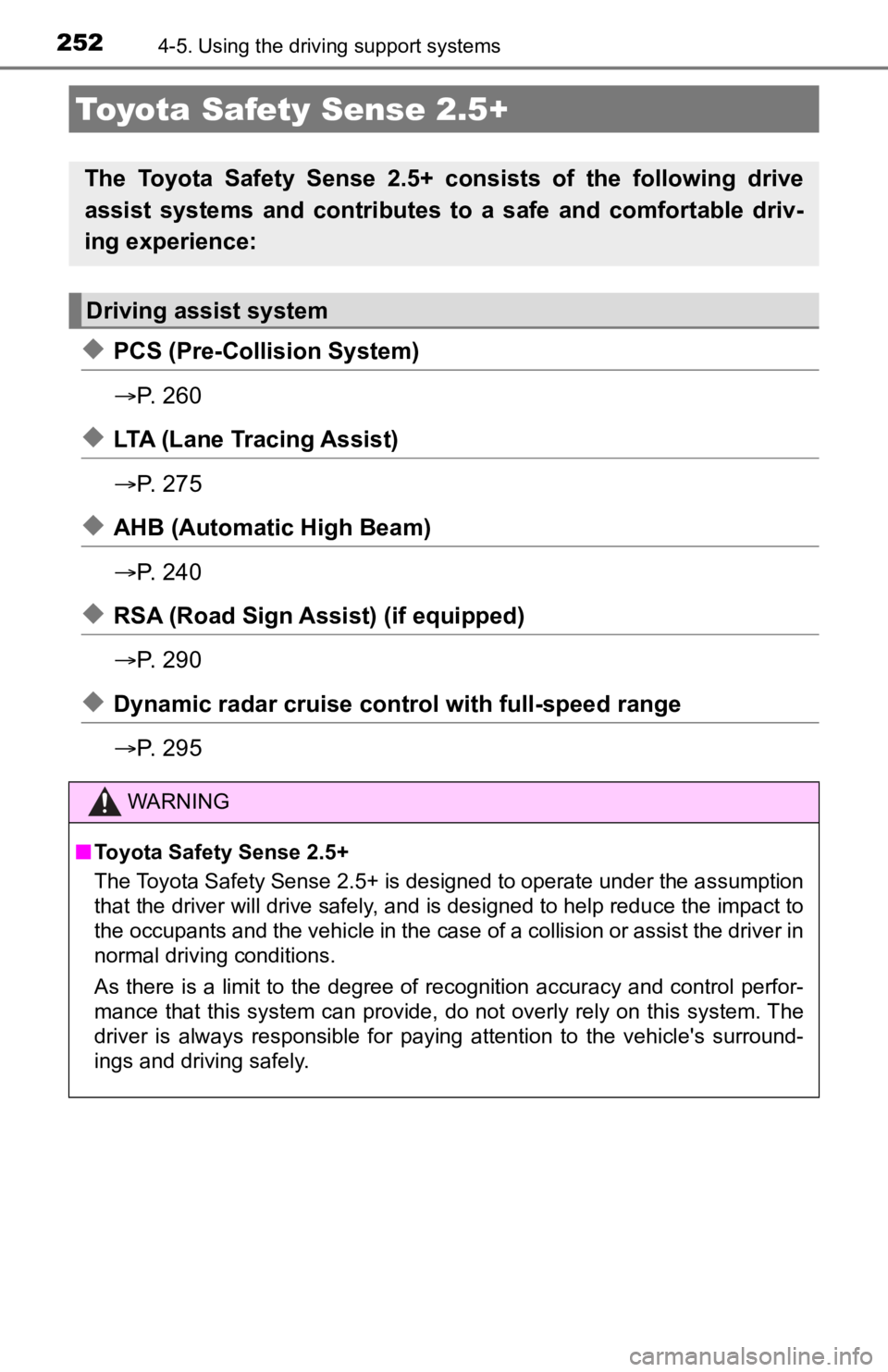
2524-5. Using the driving support systems
◆PCS (Pre-Collision System)
P. 2 6 0
◆LTA (Lane Tracing Assist)
P. 2 7 5
◆AHB (Automatic High Beam)
P. 2 4 0
◆RSA (Road Sign Assi st) (if equipped)
P. 2 9 0
◆Dynamic radar cruise control with full-speed range
P. 2 9 5
Toyota Safety Sense 2.5+
The Toyota Safety Sense 2.5+ c onsists of the following drive
assist systems and contributes t o a safe and comfortable driv-
ing experience:
Driving assist system
WARNING
■ Toyota Safety Sense 2.5+
The Toyota Safety Sense 2.5+ is designed to operate under the assumption
that the driver will drive safely, and is designed to help reduce the impact to
the occupants and the vehicle in the case of a collision or assist the driver in
normal driving conditions.
As there is a limit to the degree of recognition accuracy and control perfor-
mance that this system can provide, do not overly rely on this system. The
driver is always responsible for paying attention to the vehicle's surround-
ings and driving safely.